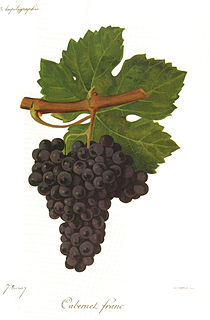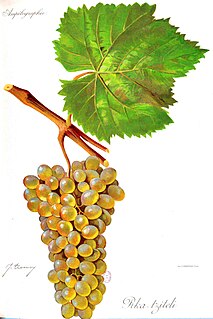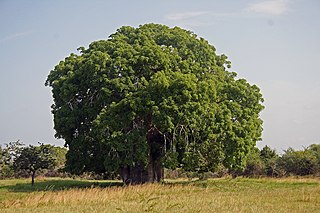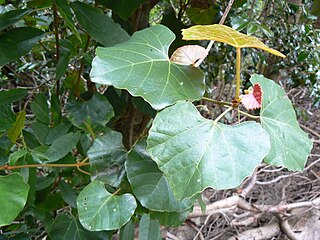
The Vitaceae are a family of flowering plants, with 14 genera and around 910 known species, including common plants such as grapevines and Virginia creeper. The family name is derived from the genus Vitis.

Cabernet Franc is one of the major black grape varieties worldwide. It is principally grown for blending with Cabernet Sauvignon and Merlot in the Bordeaux style, but can also be vinified alone, as in the Loire's Chinon. In addition to being used in blends and produced as a varietal in Canada and the United States, it is sometimes made into ice wine in those regions.

Rkatsiteli is a kind of grape used to produce white wine.

Adansonia is a genus made up of eight species of medium to large deciduous trees known as baobabs. Previously classified within the family Bombacaceae, they are now placed in the Malvaceae. They are native to Madagascar, mainland Africa and Australia. Trees have also been introduced to other regions such as Asia. The generic name honours Michel Adanson, the French naturalist and explorer who described Adansonia digitata. The baobab is also known as the "upside down tree", a name that originates from several myths. They are among the most long-lived of vascular plants and have large flowers that are reproductive for a maximum of 15 hours. The flowers open around dusk; opening so quickly that movement can be detected by the naked eye and are faded by the next morning. The fruits are large, oval to round and berry-like and hold kidney-shaped seeds in a dry, pulpy matrix.

Petit Verdot is a variety of red wine grape, principally used in classic Bordeaux blends. It ripens much later than the other varieties in Bordeaux, often too late, so it fell out of favour in its home region. When it does ripen it adds tannin, colour and flavour, in small amounts, to the blend. Petit verdot has attracted attention among winemakers in the New World, where it ripens more reliably and has been made into single varietal wine. It is also useful in 'stiffening' the mid palate of Cabernet Sauvignon blends.

Cissus is a genus of approximately 350 species of lianas in the grape family (Vitaceae). They have a cosmopolitan distribution, though the majority are to be found in the tropics.

Adansonia digitata, the African baobab, is the most widespread tree species of the genus Adansonia, the baobabs, and is native to the African continent. The long-lived pachycauls are typically found in dry, hot savannas of sub-Saharan Africa, where they dominate the landscape, and reveal the presence of a watercourse from afar. Their growth rate is determined by ground water or rainfall, and their maximum age, which is subject to much conjecture, seems to be in the order of 1,500 years. They have traditionally been valued as sources of food, water, health remedies or places of shelter and are steeped in legend and superstition. European explorers of old were inclined to carve their names on baobabs, and many are defaced by modern graffiti.

Frontenac is an interspecific hybrid grapevine that is a result of research and cross-breeding by the University of Minnesota. It was grown from a crossing of the complex interspecific hybrid Landot 4511 and a very cold hardy selection of Vitis riparia. It was released in 1996.
The state of Oregon in the United States has established an international reputation for its production of wine, ranking fourth in the country behind California, Washington, and New York. Oregon has several different growing regions within the state's borders that are well-suited to the cultivation of grapes; additional regions straddle the border between Oregon and the states of Washington and Idaho. Wine making dates back to pioneer times in the 1840s, with commercial production beginning in the 1960s.

Rhoicissus is an Afrotropical plant genus in the grape family Vitaceae and subfamily Vitoideae. There are between nine and twenty-two accepted species.

Rhoicissus rhomboidea is a climbing plant in the family Vitaceae, commonly known as the glossy forest grape. It is found in the eastern forests of southern Africa. The species was first described in 1859, treated under Cissus.

Rhoicissus tomentosa is a vigorous, evergreen vine that is indigenous to the afro-montane forests of southern Africa. It is increasingly popular as an ornamental creeper in gardens, and it has a wide range of uses in traditional medicine.

Holocacista salutans is a moth of the family Heliozelidae. It was described by Edward Meyrick in 1921. It is found in Zimbabwe and the South African provinces of KwaZulu-Natal and Limpopo.

Holocacista capensis is a moth of the family Heliozelidae. It was described by van Nieukerken and Geertsema in 2015. It is found in South Africa.

Cyphostemma mappia is a species of caudiciform succulent plant endemic to Mauritius. It is sometimes known as the "Mauritian baobab", though it is member of the grape family (Vitaceae) and unrelated to the true Baobabs of Africa.

Cotton Candy grapes are a variety of sweet table grapes whose flavor has been compared to cotton candy. The grapes were developed by horticulturist David Cain and his team at Bakersfield, California-based fruit breeder International Fruit Genetics (IFG). The grapes are produced in California by grower Grapery, which began selling them in 2011.
Kedrostis africana is a species of flowering plant in the family Cucurbitaceae. It is native to Namibia and South Africa. It has gained the Royal Horticultural Society's Award of Garden Merit as an ornamental.
















